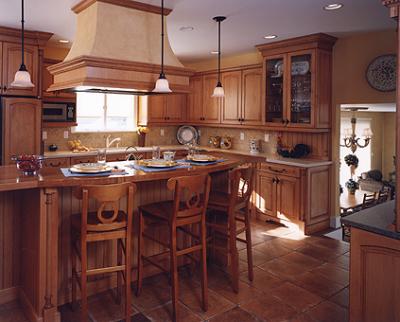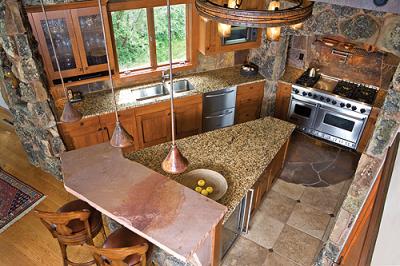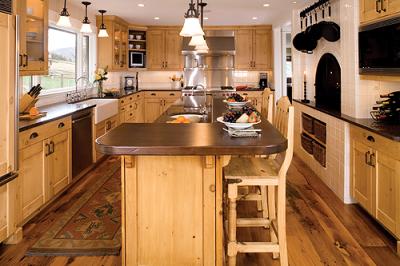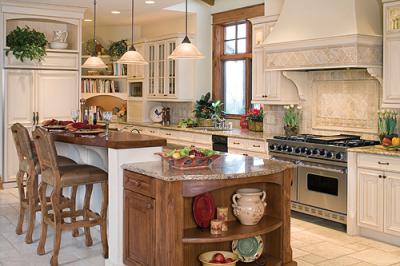Kitchens With Heart
Kristie McPhie Cabinetry

If the kitchen is the “heart” of the home, then what puts the “heart” in the kitchen? There is much written about “The Basic Work Triangle;” the National Kitchen and Bath Association has recently completed extensive research in a national study on what makes a kitchen functional as well as safe. As a result of this study, new planning guidelines were written and became a part of examination requirements as of January 1, 2007.
Certainly “safety” is an issue of the heart. Poor kitchen design can lead to inadequate counter landing areas for setting hot foods, handles hanging over edges where they can be knocked off, or open flames too close to flammable surfaces, to name a few dangers.
Obviously injuries or damage to homes are “heartbreaking” events, and I suppose there can be a certain level of heartbreak when a new home owner moves into their new “dream house” and discovers that the dishwasher door opens in the way of putting away the dishes, or they have to walk all the way around a center island every time they go from the sink to the refrigerator, the most frequently traveled path in most kitchens.
Unfortunately there is little said or written about what helps us “feel” the “heart” of a kitchen. We all know that the kitchen has evolved over the past 30 years from an enclosed work center to an open gathering place and the social center, but how do we enhance this sociability?

One of my pet peeves is the “bird on a wire” eating counter with stools all lined up like an old-fashioned soda fountain and guests craning their necks, leaning forward and back to communicate. Even a slight curve or an “L” shape eating counter can make a world of difference in the way people relate in a kitchen.
Similarly, counter heights can have a huge impact on how people interact. In a small kitchen with a young family, for instance, an eating counter at the same level as a work counter may double as a place for cookie cutters and school projects.
On the other hand, it is an interesting exercise to set a 24” counter height stool up to a work area and then try the same thing with a 30” stool designed for a 42” elevated counter and experience the psychological difference of looking someone in the eye. This aspect is even more dramatic at a “table height” counter. Try it, and see if this might be where the expression, “looking down on someone” originated.
Interestingly enough, a table height counter may be “heartfelt” when your guest or someone in the household is wheelchair bound. An understanding of “universal design” is important for any good kitchen layout.

“Distance” is another factor often overlooked in planning spaces so that families and friends gather and share space in a comfortable and friendly way. It is amazing how many kitchen plans we see with a gathering counter on one side of a huge kitchen, while the main food preparations are so far away people would have to shout to communicate.
It is not difficult to find solid information about how large a TV screen should be based upon how far away we are seated, but these principles are often forgotten when it comes to eye contact with each other.
Often I see the foundation of a new kitchen design emphasize the perfect cabinet door style and finish. Certainly the material choices have a huge impact on the overall “feel” of a space, but it is often hard to get very excited looking at door samples. Starting with words that describe the atmosphere you are trying to create and seeking materials and textures that enhance this effect may be a more satisfying starting place.
Magazine photos, showroom displays, and home shows can be useful but to really find the “heart” in your own personal kitchen, I recommend starting from the inside out. Consider planning around a piece of artwork, an antique, a “collection,” or a theme that describes what you have in mind.

Cost Considerations
The question of how much a kitchen costs as well as what constitutes “value” is complex. Although there are square foot and lineal foot systems used by builders and architects, the list of choices that affect this price is extensive. Some of today’s sophisticated high-end refrigerators and ranges alone can cost more than some allowances for all of the appliances in a modest kitchen. Stone, solid surface materials, and artistic concrete counter top installations can run four to five times the price of plastic laminate counter tops. A multitude of choices lie in between. For instance, mass-produced, even “knock down,” cabinets can be purchased for a fraction of the cost of fine cabinetry.
Details can make big differences. A simple cast aluminum cabinet knob can be purchased for five or six dollars while a hand-forged or cast piece may be 20 to 30 dollars. Say, there are 50 such items : do you spend $250 or $1,500 while being equally functional? And how does one place value on aesthetics?
Cabinetry construction and materials vary greatly as well. A well constructed, durable cabinet with lifetime warranted hardware in a simple style and finish may cost less than a mass-produced lower quality cabinet with a labor intensive door style and a multi-stepped finish. A basic finish may be a sanding and a single coat of finish while a series of sanding, sealer and catalyzed finish steps designed to last 20 to 30 years may take 13 steps or more. Obviously labor means time, which means money, but perhaps the cost per year of use is less.

The “value” discussion becomes a matter of personal taste and priorities. How important is your kitchen? How does it affect your quality of life? Stress tests indicate that good task lighting can improve health and reduce anxiety. What then of the warmth of indirect lighting? How important is easy care? Working together with others comfortably in your kitchen? Your definition of beauty?
Thoughts come to mind. How much time do you spend in your kitchen? Does it get hard use? Is it a gathering place for friends and family? Do you live alone and rarely entertain? How long do you want it to last? A poorly designed kitchen with an inconvenient layout or poor storage is apt to cost nearly as much as one that is well thought out and created to your personal taste. Even a modest kitchen is apt to be the largest investment in your home, so it is worth getting it right. A newly remodeled kitchen enhances the sale price of a home.
Over the years, one of my favorite answers to the question of “How much do kitchens cost?” has been, “They tend to run in the price range of cars.” A very sophisticated kitchen with top of the line appliances and counter tops might be similar to a very high-end luxury car. Since most of us are apt to purchase more cars in a lifetime than kitchens it helps to get a feel for the budget. To me this analogy also helps point out the value of investing in a well designed quality built kitchen.
So...what kind of kitchen do you want to drive?
~ Kristie Eagle McPhie, Certified Kitchen Designer, co-owns McPhie Cabinetry in Bozeman. She, her husband Scott, and their staff have created numerous award winning and published projects throughout their 30 years in business together, while raising three children. Kristie currently serves on the Member Standards Committee of the National Kitchen and Bath Association. Her e-mail is [email protected].
Leave a Comment Here
Leave a Comment Here